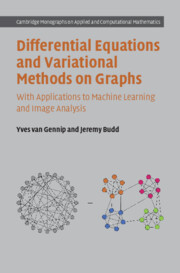Refine search
Actions for selected content:
3386582 results
The Portrayal of Pagan Worship in the Hebrew Bible and Ancient Judaism
- Coming soon
-
- Expected online publication date:
- March 2026
- Print publication:
- 01 April 2027
-
- Book
- Export citation
Prescribing Psychiatric Medications
- The How, Why, and Why Not
- Coming soon
-
- Expected online publication date:
- March 2026
- Print publication:
- 31 March 2026
-
- Book
- Export citation

Differential Equations and Variational Methods on Graphs
- With Applications to Machine Learning and Image Analysis
- Coming soon
-
- Expected online publication date:
- March 2026
- Print publication:
- 28 February 2026
-
- Book
- Export citation
Nuer Messianic Judaism
- Truth and Mediation in the Ethiopia-South Sudan Borderlands
- Coming soon
-
- Expected online publication date:
- March 2026
- Print publication:
- 28 February 2026
-
- Book
- Export citation

Governing AI
- A Primer
- Coming soon
-
- Expected online publication date:
- March 2026
- Print publication:
- 31 March 2026
-
- Book
- Export citation
The Archaic and Early Classical Greek World
- Using Coins as Sources
- Coming soon
-
- Expected online publication date:
- March 2026
- Print publication:
- 31 March 2026
-
- Textbook
- Export citation
Reason and the Good in Leibniz, Kant and Hegel
- Theodicies of Freedom
- Coming soon
-
- Expected online publication date:
- March 2026
- Print publication:
- 28 February 2026
-
- Book
- Export citation
Development and the Tribal Question in India
- Contours, Context, and Contestations
- Coming soon
-
- Expected online publication date:
- March 2026
- Print publication:
- 01 April 2027
-
- Book
- Export citation
Pointing
- Culture, Development, and Evolution
- Coming soon
-
- Expected online publication date:
- March 2026
- Print publication:
- 31 March 2026
-
- Book
- Export citation
Antitrust and Competition Policy
- A New Foundation
- Coming soon
-
- Expected online publication date:
- March 2026
- Print publication:
- 31 March 2026
-
- Book
- Export citation
The Judgment of the Provinces
- The Roman Empire and the Origins of Law and Society
- Coming soon
-
- Expected online publication date:
- March 2026
- Print publication:
- 31 March 2026
-
- Book
- Export citation
Transmission Lines
- Equivalent Circuits, Electromagnetic Theory, and Photons
- Coming soon
-
- Expected online publication date:
- March 2026
- Print publication:
- 31 March 2026
-
- Book
- Export citation
Rethinking Beethoven and the Enlightenment
- Coming soon
-
- Expected online publication date:
- March 2026
- Print publication:
- 28 February 2026
-
- Book
- Export citation

The Life of Freedom in Kant and Hegel
- Coming soon
-
- Expected online publication date:
- March 2026
- Print publication:
- 31 March 2026
-
- Book
- Export citation

Art, Nature, and the Body in Early Medieval Britain and Ireland
- Coming soon
-
- Expected online publication date:
- March 2026
- Print publication:
- 31 March 2026
-
- Book
- Export citation
People For Oil
- Citizen Mobilization in the U.S. and Canadian Fossil Fuel Industries
- Coming soon
-
- Expected online publication date:
- March 2026
- Print publication:
- 31 March 2026
-
- Book
- Export citation

Reluctant Abolitionists
- Britain and the End of the Colonial Death Penalty
- Coming soon
-
- Expected online publication date:
- March 2026
- Print publication:
- 31 March 2026
-
- Book
- Export citation

Responding to Authoritarian Populism at the European Court of Human Rights
- A Calibrated Framework
- Coming soon
-
- Expected online publication date:
- March 2026
- Print publication:
- 31 March 2026
-
- Book
- Export citation

The Cambridge Companion to Florence B. Price
- Coming soon
-
- Expected online publication date:
- March 2026
- Print publication:
- 31 March 2026
-
- Book
- Export citation
Navigating the Souring Seas
- The Global Experimentalist Governance of Ocean Acidification
- Coming soon
-
- Expected online publication date:
- March 2026
- Print publication:
- 31 March 2026
-
- Book
- Export citation
